This is from the June 7, 1943, edition of the Altoona Tribune (Pennsylvania).
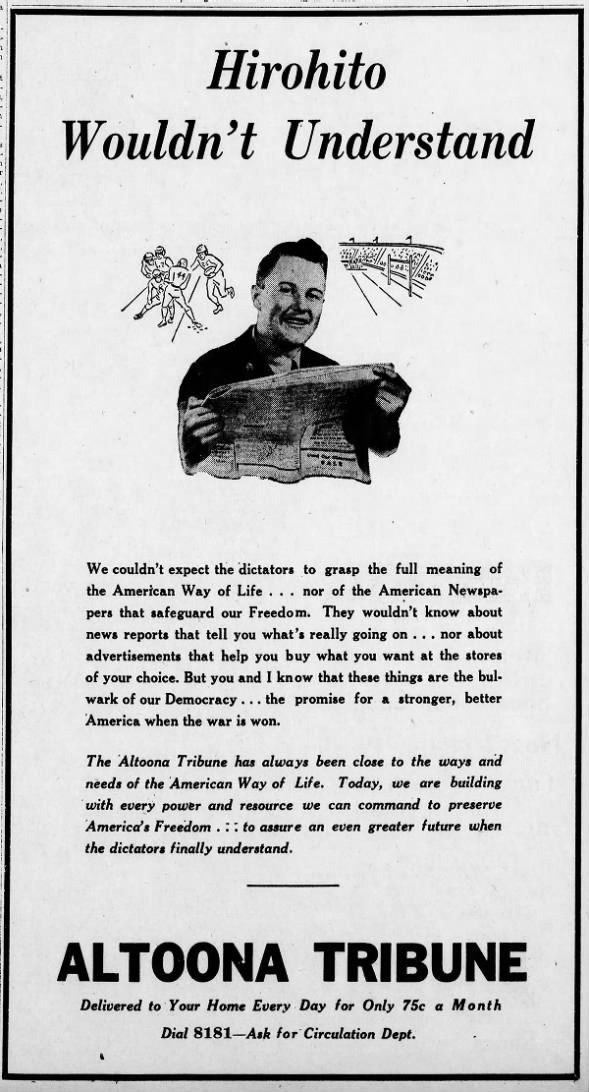 07 Jun 1943, Mon Altoona Tribune (Altoona, Pennsylvania) Newspapers.com
07 Jun 1943, Mon Altoona Tribune (Altoona, Pennsylvania) Newspapers.com

This is from the June 7, 1943, edition of the Altoona Tribune (Pennsylvania).
 07 Jun 1943, Mon Altoona Tribune (Altoona, Pennsylvania) Newspapers.com
07 Jun 1943, Mon Altoona Tribune (Altoona, Pennsylvania) Newspapers.com
Not long ago I found a message in Facebook Messenger I hadn’t noticed earlier because it was from a stranger. He’d sent a screenshot of a photo, asking if it was mine and where it had been taken.
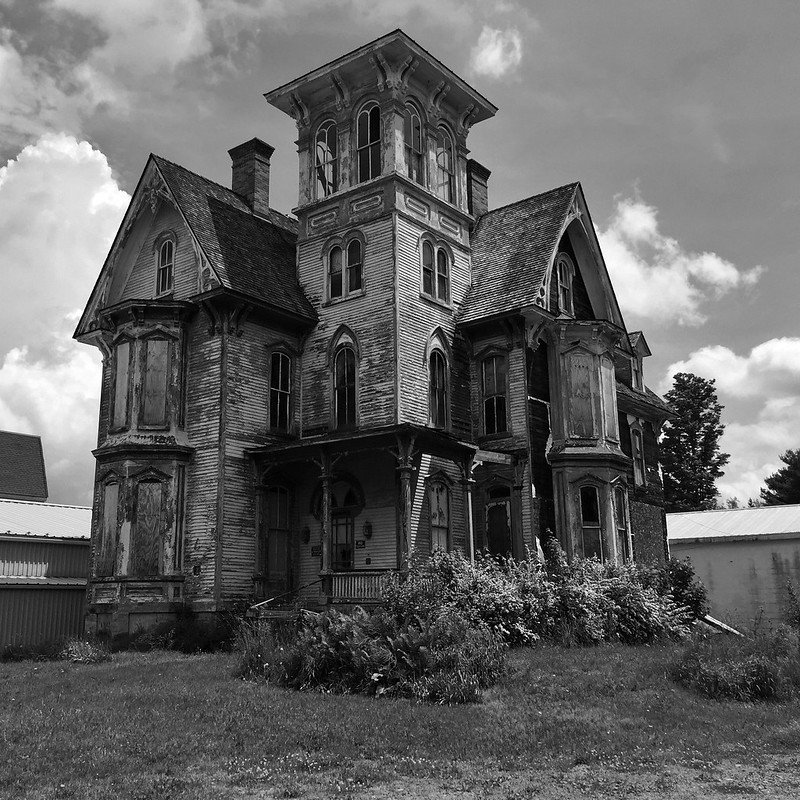
It was my photo, so I sent back a screenshot from Apple Maps based on the location data, which included “Old Hickory Lanes.” Later I found out there is a bowling alley next to the subject of this post, a house fondly known as “Old Hickory [Tavern],” or now more formally as F. W. Knox Villa.
The question roused my curiosity. Located in downtown Coudersport, Pennsylvania, Old Hickory when I photographed it in May 2015 was a moldering shell of a building whose open windows invited pigeons and no doubt bats in to roost. Fixed up some, but not too much, it would have been the perfect setting for a 1960s horror film. But you could imagine how grand it must have been in its late 1800s prime. It was a shame to see it slowly rotting.
I looked up Old Hickory (thank you, internet) and found out it had been purchased and is being slowly restored. The new owner commented people are disappointed to learn Old Hickory is not on a big lot in the countryside. On one side, it bumps up against the bowling alley, while the other is separated by a bit of yard from the Allegheny River, which in Coudersport looks like a canal.
The new owner mentioned a surprising lack of photos to help guide the interior restoration, then said someone sent a box of interior photos, a treasure trove. It sounds like the owner wants it to look as much like it did in its heyday vs. a modern makeover.
I don’t know what the owner’s intention is. Someone speculated it could become a bed and breakfast, which would draw me back to Coudersport (close to Cherry Springs State Park, an International Dark Sky Park). Whatever Old Hickory will be used for, finally the local pigeons and bats have had to move on.
More about the F. W. Knox restoration: Facebook • Instagram • Website
Every now and then I get an email updating me on my Google Maps photo statistics. As of today, these photos have 10,000+ views. The surprises? The chicken and the nondescript view of Lincoln Park Zoo’s south lagoon. That so many people are looking at Beaubien Woods. And that the photo of the Rainbow Bridge at Niagara Falls didn’t make the cut as of today. Not looking like it will for a long time.
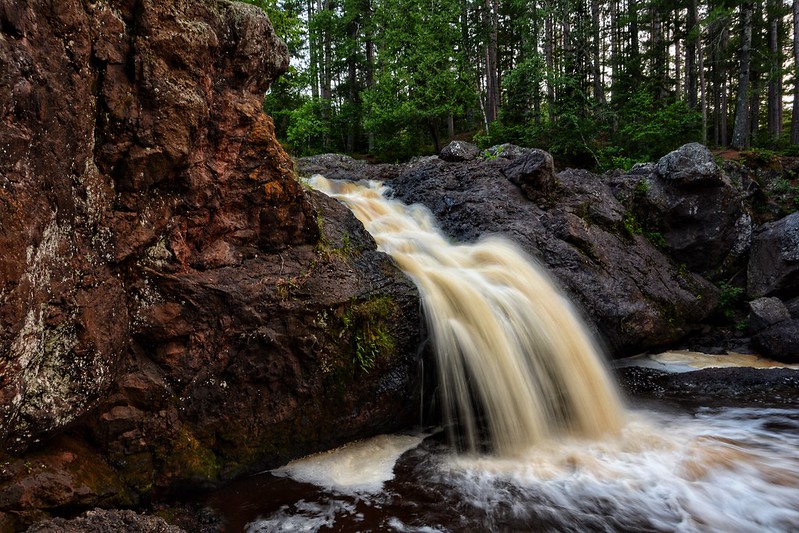
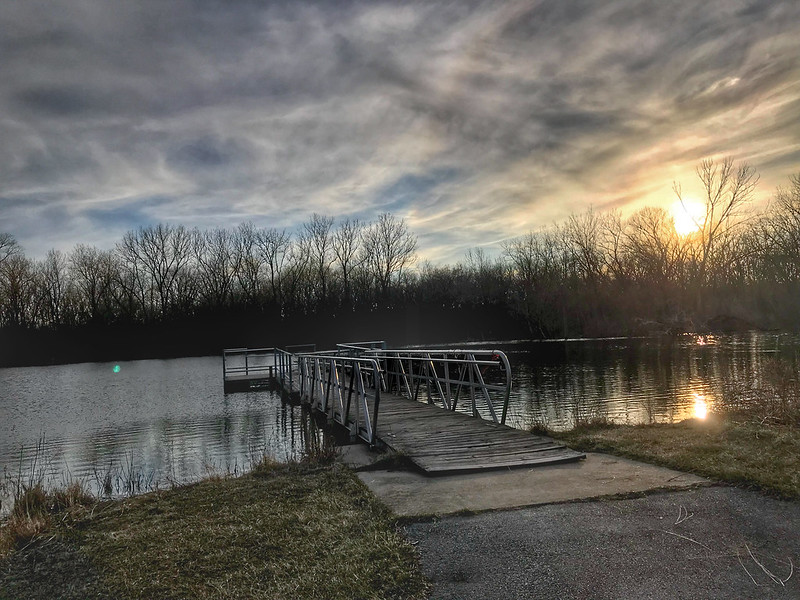
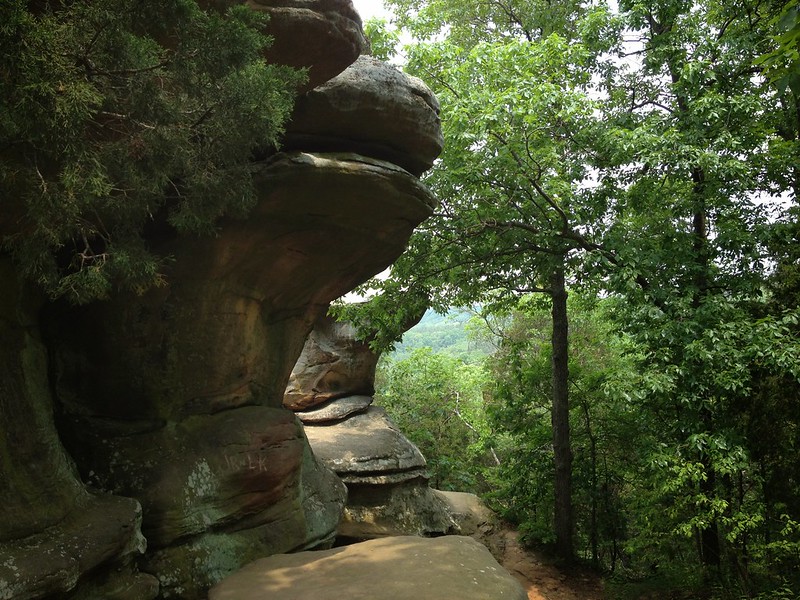


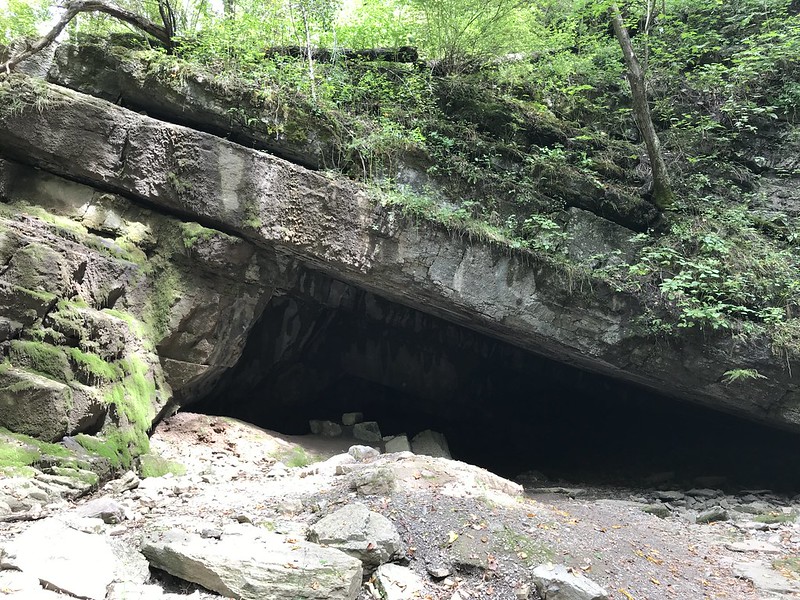

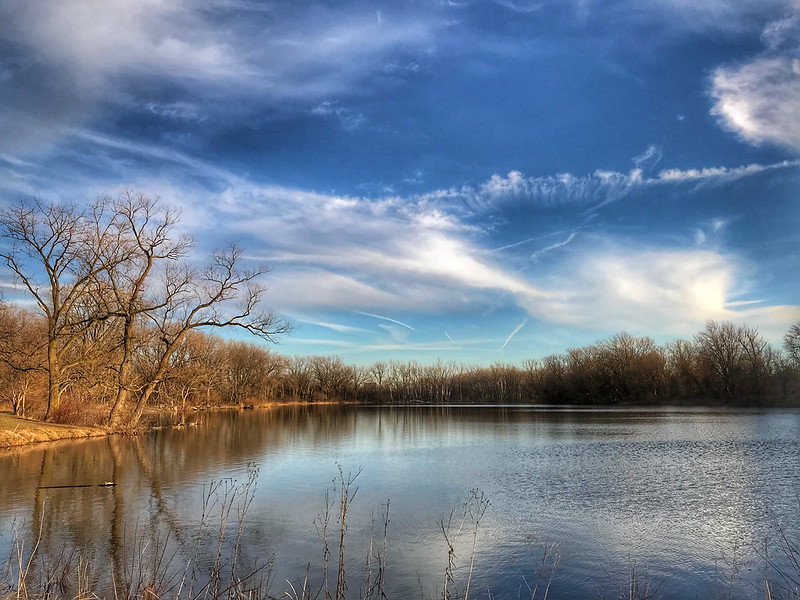


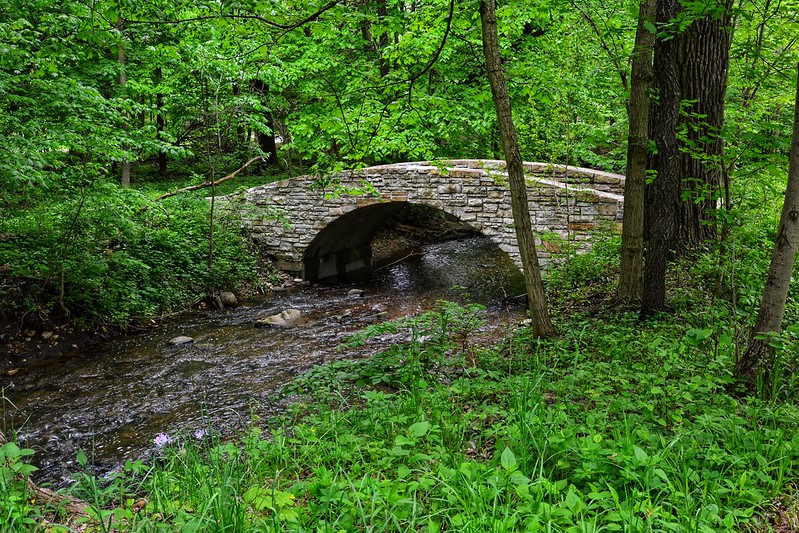

Finally, at six figures:
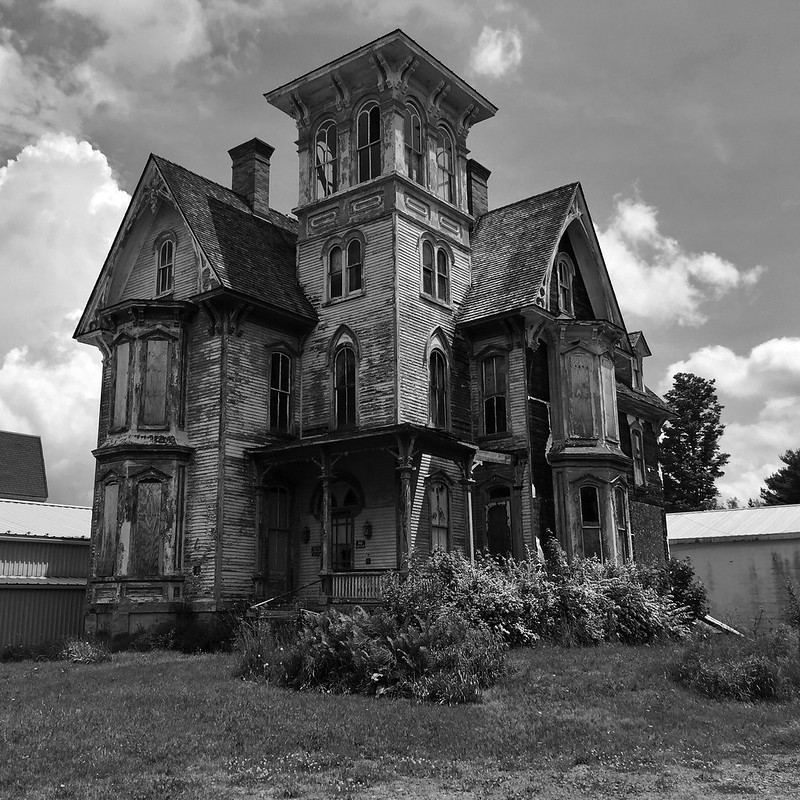

Marietta Schirf was my dad’s youngest sister. He said he didn’t know how she snuck into the Armed Forces because he was sure she didn’t meet the minimum height requirement.
At a 1980s July 4th concert on Capitol Hill, E. G. Marshall officiating, veterans by branch were asked to stand up. When the turn came for the Air Force, she stood and whooped, to the surprise of our neighbors on the grass. I asked why Air Force, and she answered she’d been in the Army Air Corps. That’s the first I’d heard that.
Aunt Marietta died in the mid-90s. How she would have appreciated the resources of the internet. She once took me to the Library of Congress to look up articles on sugalite.
I will have to look up Front and Center. On the internet.

Facebook has many flaws, but it does alert me when events I might be interested in are coming up. A few weeks ago I found out about the world premiere of Octave Chanute: Patron Saint of Flight, at Indiana Dunes Visitor Center. I knew the Chanute name vaguely from the old Air Force base, but I couldn’t have told you then where the base had been located or why it was named Chanute. This sounded like a way to get in a visit to Indiana Dunes, learn something, and spend what might be otherwise a dull winter afternoon, depending on the weather.
The parking lot was unusually crowded, and when J and I walked in about a half hour early, a good-sized group was watching Shifting Sands: On the Path to Sustainability, a documentary on the history of Indiana Dunes and efforts to restore what can be restored. It’s meant to inspire, but it’s also tragic and depressing.
By the time Shifting Sands ended and Octave Chanute was scheduled to begin, the auditorium had filled up, even when extra folding chairs were brought out. Soon it was standing room only.
Simine Short, author of Locomotive to Aeromotive: Octave Chanute and the Transportation Revolution, and young director Paul Nelson introduced the film. I mention Nelson’s relative age because the audience was mostly 50 plus, possibly 60 plus, which disappointed me because I would like to see younger people interested in history. Of course, when I was younger none of my peers would have been interested, either.

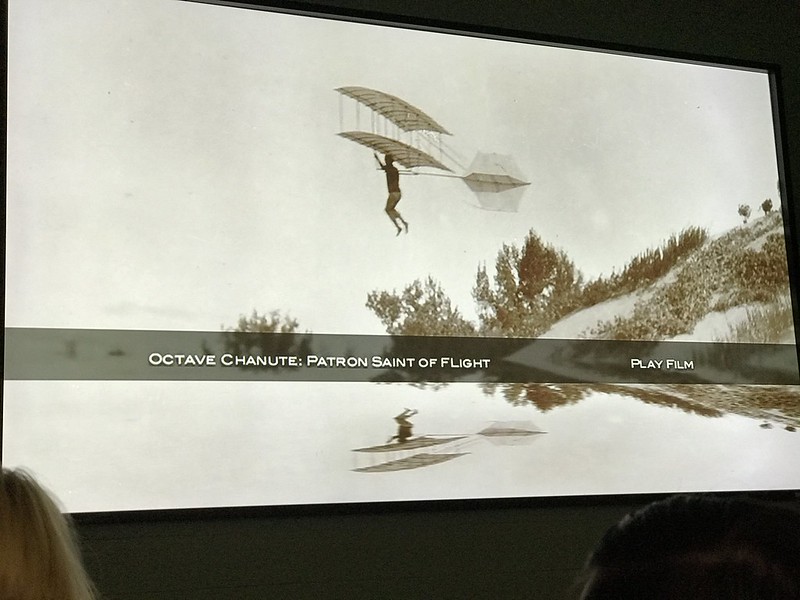
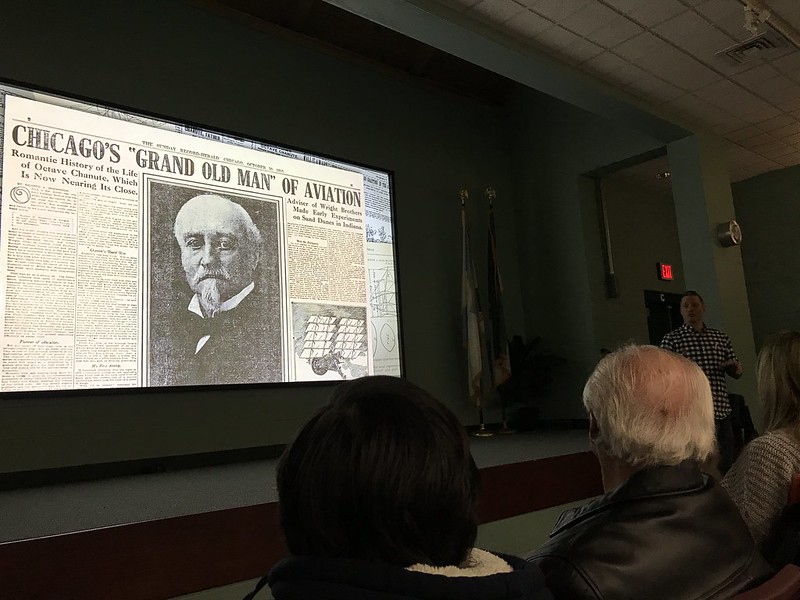
The presentation began with some technical glitches (flashbacks to every high school A/V club everywhere!), but my ears perked up at the mention of the Portage Bridge, accompanied by a photo I recognized immediately. Through this film, I found out Octave Chanute was the engineer behind the much-loved railroad bridge over the Genesee River at Letchworth State Park in New York.
Known for his bridges, Chanute was called in when the original timber trestle, the longest and tallest wooden bridge in the world when it opened in 1852, was reduced to ashes on May 6, 1875, after a train had passed over (spark?). Chanute’s iron replacement opened only 86 days after the fire. According to Short’s book, the piers were rebuilt and the uprights and girders strengthened in 1880, “making the bridge better than new.”

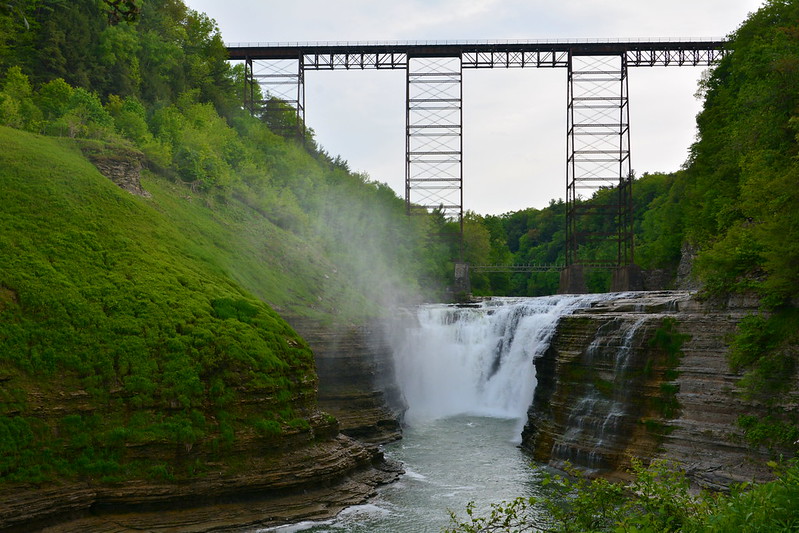

Although modern Norfolk Southern trains were restricted to 10 miles per hour over the Letchworth gorge, Chanute’s bridge lasted until 2017, when the Genesee Arch Bridge opened. The state of New York declined the offer of the 1875 bridge, the last of which was demolished on March 20, 2018. I’d been fortunate to visit the old bridge one last time in 2015. When I’d found out about the premiere of this film, I’d had no idea it would take me back to perhaps the most iconic of my childhood memories. I remember walking along those tracks with my brother during one of his visits.
But wait! There’s more!
My ears perked up again at the mention of Kinzua Bridge. I’d found out about Kinzua Bridge State Park when I was looking up Kinzua Dam, another place I’d visited as a child, for my 2015 swing through Ohio, New York, and Pennsylvania.
It turns out that Octave Chanute was behind the original 2,000-foot-long Kinzua Bridge (or Viaduct), built in 1882 at 302 feet above the narrow valley floor. Short calls it Chanute’s “most spectacular bridge.” She adds that the bridge was rebuilt in 1900 “to keep up with the increasing volume and weight of the coal traffic.” Carl W. Buchholz redesigned the superstructure on the original masonry foundation piers.
By 1959 the viaduct failed safety inspections and was closed to commercial rail traffic. Restoration began in 2002, but in 2003 an F2 tornado “tore eleven towers from their concrete bases. Investigators found that the anchor bolts, installed under Chanute’s supervision, had rusted over the past 120 years.” Over time, the materials had failed the design.
After seeing this film, I’m even happier that I had the opportunity to walk out on what’s still standing of Kinzua Bridge and get a look at the remnants resting in peace on the valley floor. Even destroyed, Kinzua Bridge is indeed a “spectacular” sight.
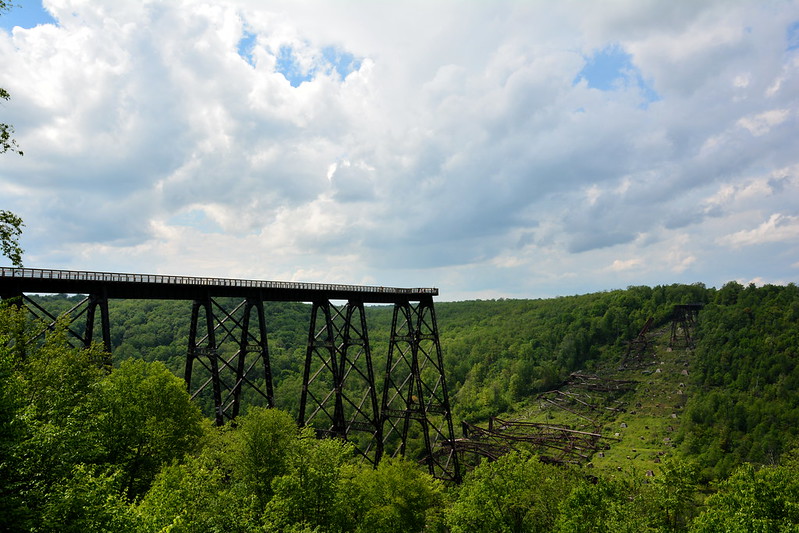
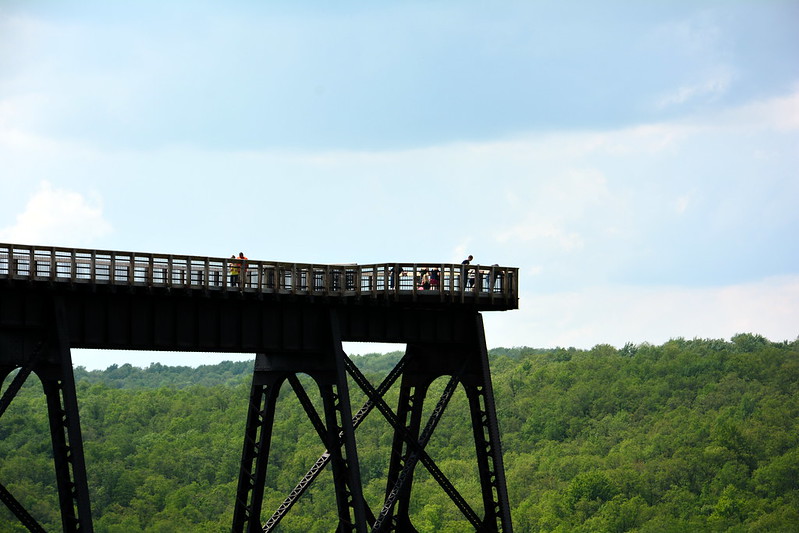
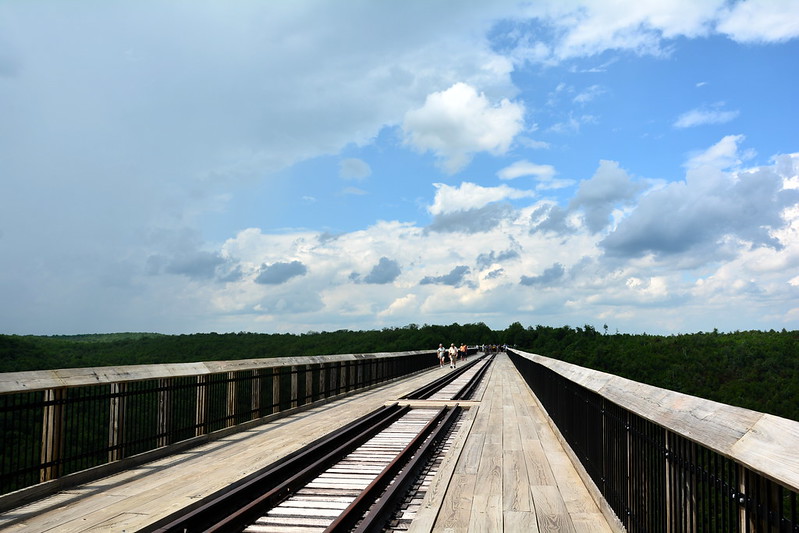

Of course, most of the film was about Chanute’s contributions to flight and relationship with Wilbur Wright (rocky; Chanute was an open source kind of man and Wilbur believed in closely held information). What’s the link to Indiana Dunes? With their lake winds, elevations, and soft sand, the Dunes were Chanute’s choice for safely testing their experiments — the Kitty Hawk of the Midwest.
Octave Grill in Chesterton is named for Octave Chanute. Found out they serve a Chanute burger.


In December I’d checked out Horseshoe Curve from the parking lot, but hadn’t been up to the top since September 1988 — er, 31 years ago . . . Not long after, a visitor center and 288-foot funicular were built and opened in 1992. Not knowing anything about the funicular, I was surprised to find it doesn’t run constantly, only on the hour and half hour.
We spent about 15 to 20 minutes looking over the exhibits while waiting. I appreciated the one showing how the Curve had been carved out — I’ve never been able to visualize it or how it would have looked before. Another highlighted the wreck of the Red Arrow in 1947, which killed two dozen and injured more than 100.
The funicular cabins, which were made in the Durango and Silverton Railroad shops in Colorado, ascend and descend at the same time. They pass at a circle part of the way up (or down). I expected the cabin to veer to its right, but they swing to the left to pass. Very British.
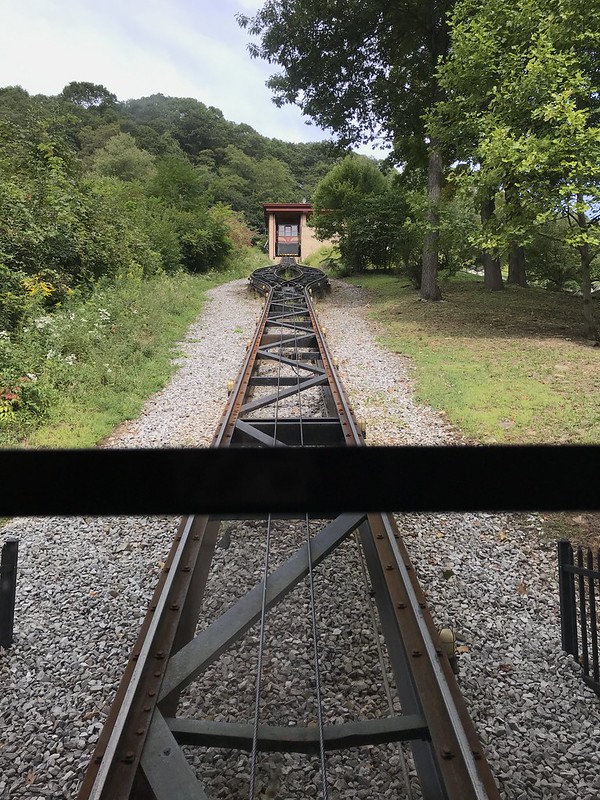
Up top the cars from the summer derailments (two!) are visible but not close. We’d picked up a list of scheduled trains at the visitor center, but am not sure we matched any that went by to it — certainly not the “Oscar” (trash train) heading west. In addition to the Oscar, we saw an intermodal plus helper locomotives returning in pairs as they do. No Amtrak — the eastbound Pennsylvanian had gone through earlier. I’d be on the westbound Pennsylvanian later in the afternoon, while it was still daylight.


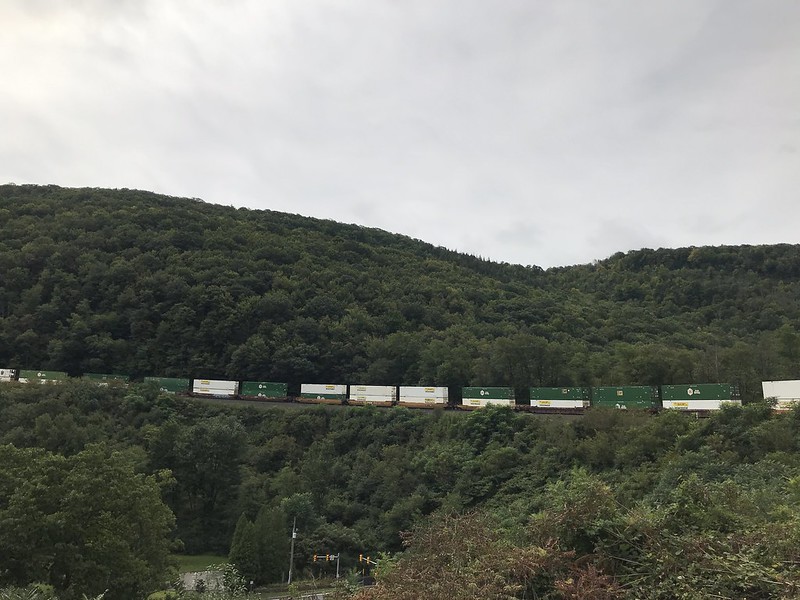
While we watched the trains we found ourselves plugging our ears. One thing I didn’t remember from all those years ago was the screech of metal on metal, the wheels and brakes as they fight the curve and the incline.
It seemed fitting we got a wave from the locomotive of the last train we saw — one of the few times I’ve seen a woman engineer.

Our final shopping stops were Hillside Farm, where I bought whoopie pies, and Ridgeside Cider Mill, where V. picked up their first cider of the season and I added to my soap collection.

Years ago a relative had posted about Tytoona Cave (more formally, Tytoona Natural Area Cave Preserve), the name an awkward mashup of “Altoona” and “Tyrone.” Previously, its location had seemed a mystery to me, and December wasn’t the best time to visit it. I’d looked again recently and found out it’s connected (more or less) to Arch Spring in Sinking Valley which my cousin had pointed out to me a couple of years ago. Now I could find it easily on Google Maps — as it turns out, it’s on T495 off Kettle Road, less than a half mile from Ridgeside Cider Mill. Off we went.
There’s a slight cutout parking area, with the trail entrance marked by green barrels. Steps, some eroded, built in 2001 by the Tytoona Cave Preserve Committee and members of the Huntingdon Co. Cave Hunters, lead down into the sinkhole. Normally a stream flows into the cave, but it was bone dry. This made walking in without hiking shoes a lot easier.


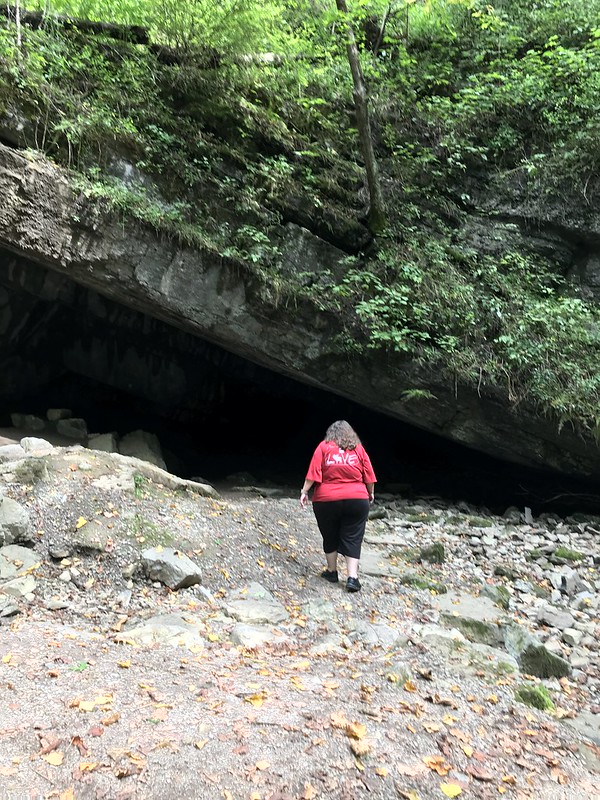
If you walk far enough into the cave, you can sign a register. I didn’t make it nearly that far. I didn’t have a flashlight, and was surprised by how dark it became a short way in. It’s easy to see why people in Tytoona Cave videos wear helmets with headlamps — it’s too dark to see the low ceiling that your head will hit.
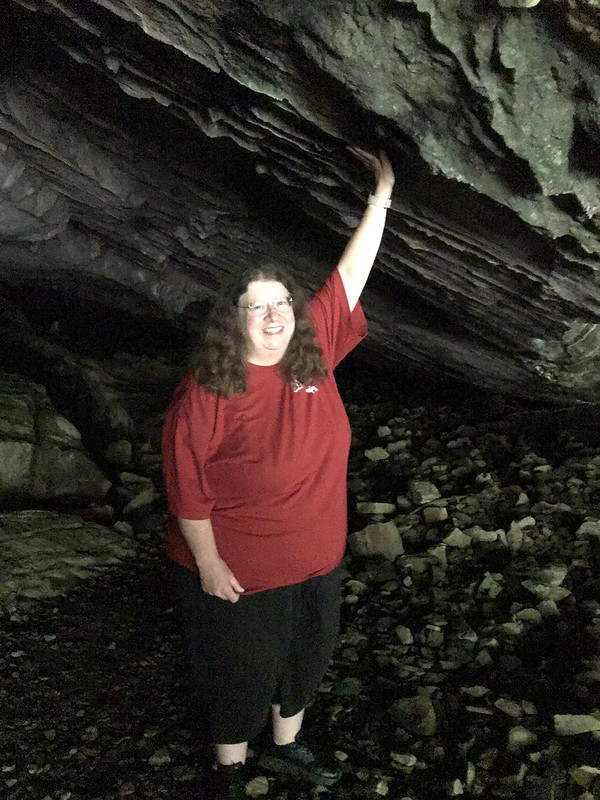



The stream bed through the sinkhole may have been dry, but there was running water somewhere in the darkness. In this video, the cave walls and ceiling amplify the sound, but I suspect the cave’s water would make a respectable noise without the help.
It felt weird and creepy to hear water rushing nearby without being able to see it. If I’d had a light, a helmet, and a better physique, I wonder if I could have gone as far as the register or even the first sump . . .
On the way out, we saw a poster about Pennsylvania bats. Short version: Tytoona Cave is not the best place to find them.

And so back to packing for the return trip on the Pennsylvanian and Capitol Limited.
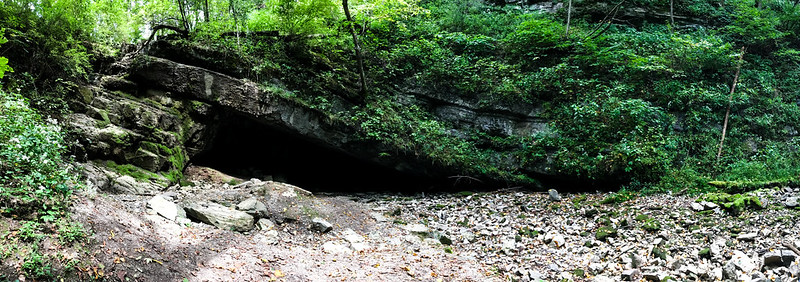
First, we returned to Shaver’s Creek Environmental Center, where the buildings were open. The center has a discovery room with amphibians and reptiles.
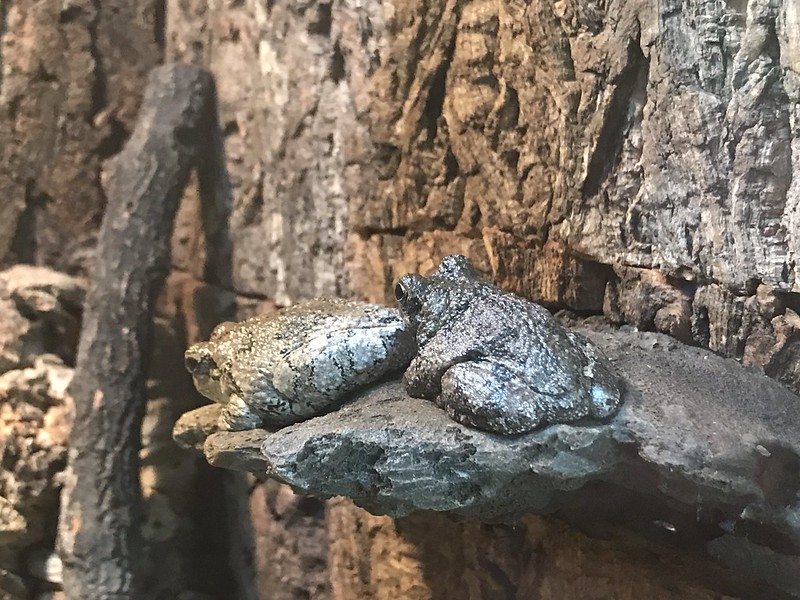

On the earlier visit, we hadn’t noticed the raptor aviary behind the main building. Shaver’s Creek is home to a surprising variety of raptors — peregrine falcon(s?); bald and golden eagles; broad-winged, red-shouldered, and red-tailed hawks; barn, barred, eastern screech, and great horned, screech owls; and black and turkey vultures. My favorite was black vulture Matilda. I’m not sure I’ve seen one in flight ; turkey vultures are more common at this latitude. I know I’ve never seen one this close up. No photo due to the cage, but Matilda has a surprisingly sweet face attached to her bald head. The darker coloring may make them more appealing than turkey vultures to human eyes.
Before leaving, I sat by the windows overlooking bird feeders. As seems to happen to me, a hummingbird flew up, looked at me tauntingly, and flew off before I could take a photo. Typical.
Off to elk country in Benezette. This time we didn’t see any elk at the campground. We made a stop at the visitor center, where tables with local goods had been set up next to the gift shop. It was here I discovered Moonshine Chocolate . . .
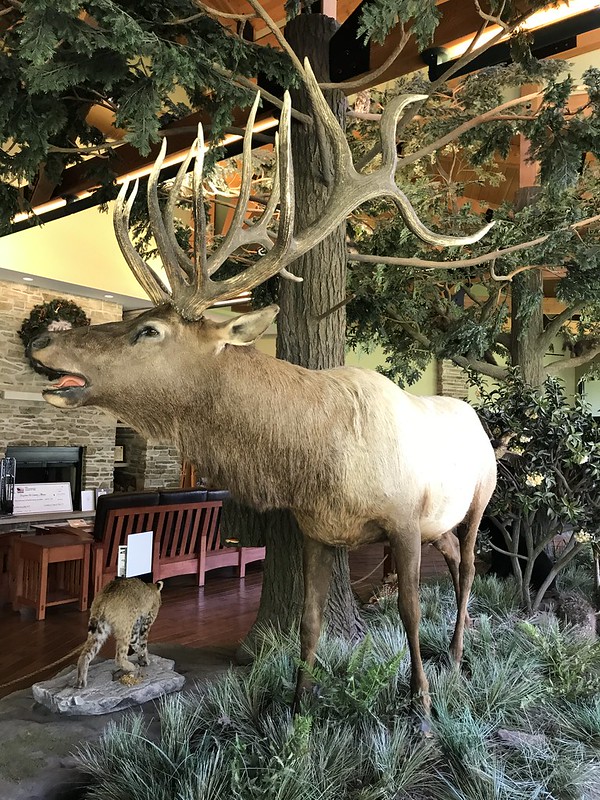
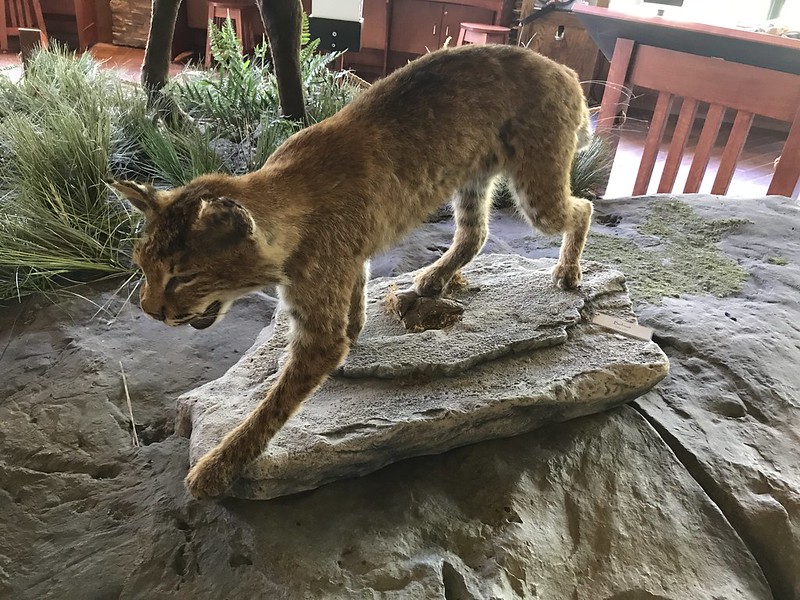
At the Winslow Hill overlook, we didn’t see anything at first, but a handful of turkeys and a white-tailed deer family (buck, doe, two older fawns) appeared.


After we ate dinner at the Benezette Hotel (where none of us ordered the elk burger), this one crossed the road while following others into the woods.

In another place, we joined a little crowd watching a small herd at some distance, including nursing offspring.
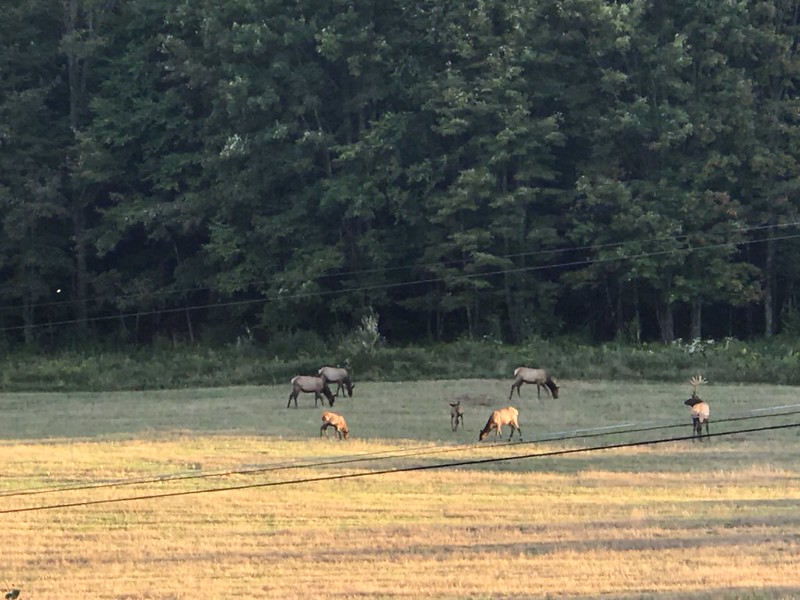


In all. we counted 45 to 50 elk (or wapiti), including this last one on a rise next to the road.

When I visited Pine Creek Gorge (Pennsylvania’s Grand Canyon) in 2015, I hadn’t expected to return. My cousin and his wife suggested a trip there, so off we went. A stop in Wellsboro for lunch was my idea. After visiting Wellsboro in 2015, I’d read it’s one of Pennsylvania’s most picturesque towns. Soon after that, I’d heard about the Wellsboro Diner, which looks like an old rail car but likely isn’t. I never thought I’d be able to go there and am grateful for the chance to put away a grilled cheese and a side of cottage cheese. (I’m strange.)


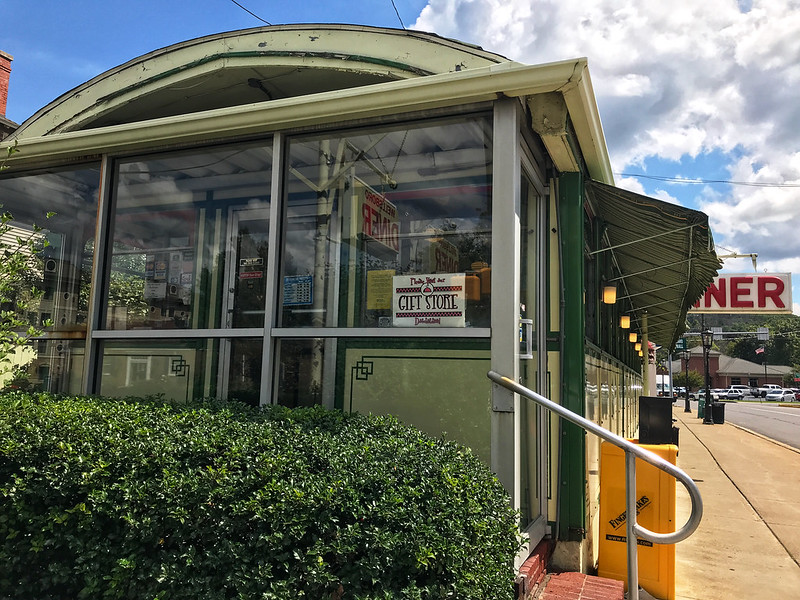
Wellsboro itself seemed busy, perhaps due to a lot of road construction. I think it’s best approached from the west, where it seems like a surprise after miles of hills and countryside.
I remembered a red church on the way to Leonard Harrison State Park and asked to stop there again. A room, still in progress it appears, had been added to the back since 2015. This church is so distinctive the state park gift shop sells postcards of it. From the back of one of them:
Before entering Leonard Harrison State Park at the PA Grand Canyon, one will pass The Little Red Church. This landmark was buil in 1897, and donns [sic] eight beautiful stained glass windows. Because bricks were expensive, it was built of basswood siding with dado cuts to resemble brick. Electricity was installed in 1954.

Our next stop was Leonard Harrison State Park with its visitor center and gorge overlooks. No spring flowers this time, but the views of the now second-growth forest that’s covered the scars of 19th- and 20th-century clear-cutting are inspiring. If I lived in the area and were more mobile, I’d take the trail down past waterfalls and other wonders. (And, of course, have to take it back up.)

As we headed out, we passed a statue I didn’t remember from 2015 — a tribute to Civilian Conservation Corps workers. It appears the CCC was active all over the Alleghenies of Pennsylvania, replanting Pine Creek Gorge and building the facilities at our next destination, Colton Point State Park on the western rim.
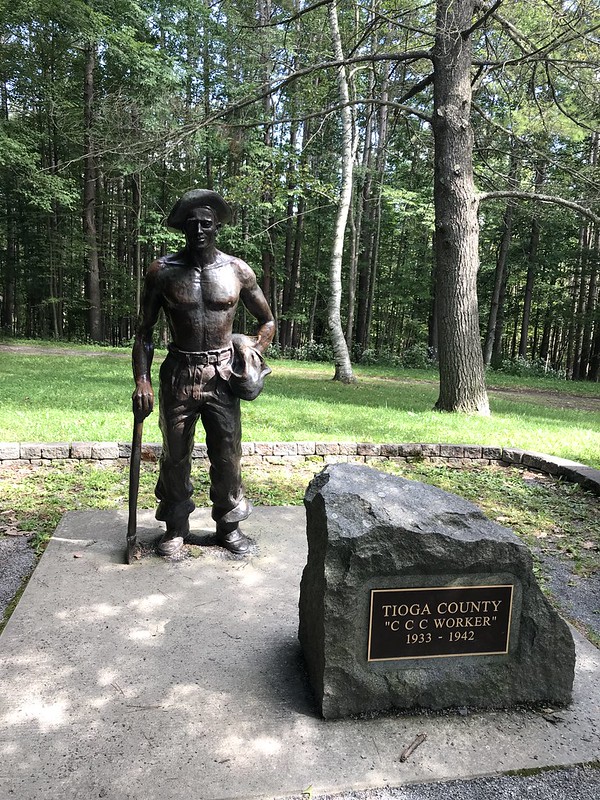
I had not gone to Colton Point in 2015. It’s described as more “rustic” or “primitive” than Leonard Harrison — take your pick. Not surprisingly the road up to Colton Point is twisty with steep drop-offs. At the
We noticed the same rocky wall we’d seen from Leonard Harrison. I read later that when the trees are bare Pine Creek Gorge sports more of a western canyon look.
When we got back to the main road/entrance, we saw what I had half noticed before — a small parking lot. Across from the parking lot? A fancy overlook with a view rivaling those from Leonard Harrison across the way.
As we stood in the circular overlook, which reminded me of Letchworth State Park in New York minus the waterfall, a parade of heavy construction vehicles headed past us uphill — strange, we thought, since it was now late afternoon. We tried to imagine them navigating the narrow “rustic” roads through the trees at the top. I wondered why they were there. Rustic road repair?

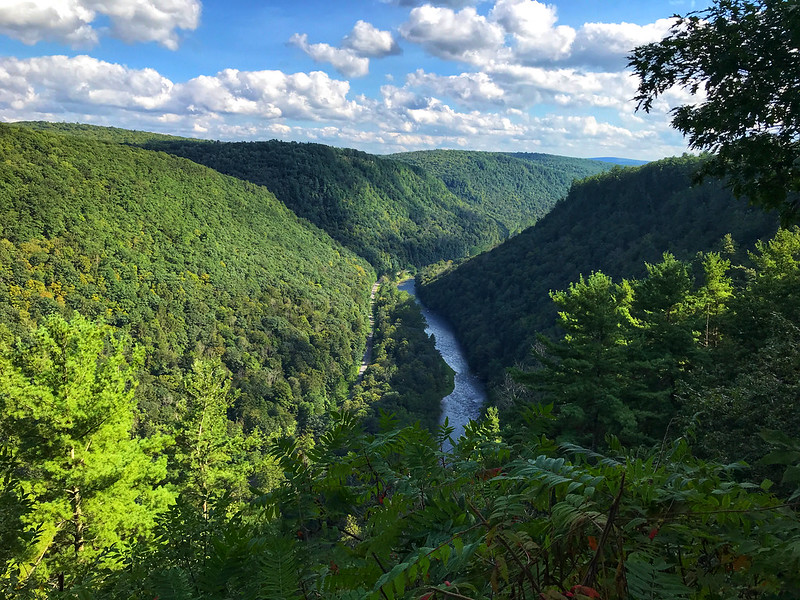
We visited my parents’ graves at Logan Valley Cemetery, located across from the high school. A cousin I haven’t seen in decades had left flowers at my dad’s grave. His flag holder for veterans still has a metal medallion. The newer medallions are plastic thanks to theft. Once upon a

In Sinking Valley, this little mare and her young’un attract customers to Hilltop Farm. There’s also a wee donkey.
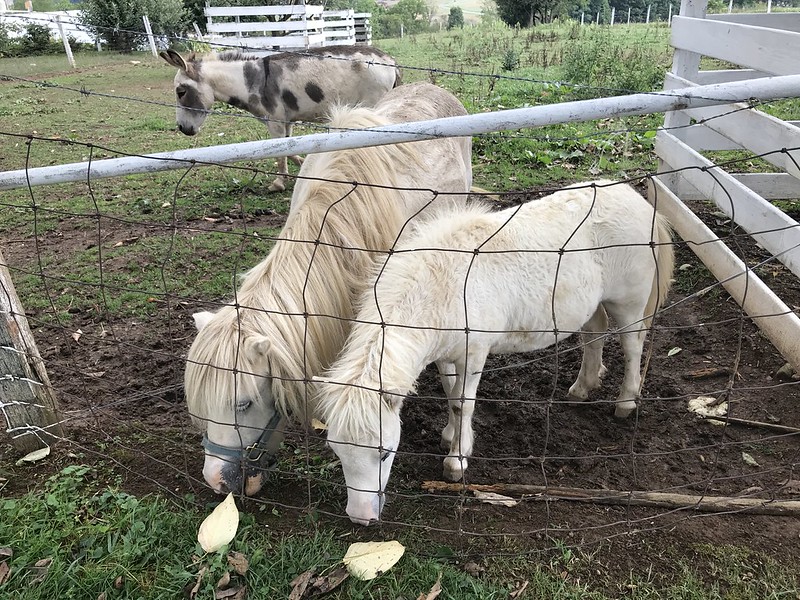
On to Whipple Dam State Park, which was new to me. It’s yet another part of our legacy from the Civilian Conservation Corps. As it was Labor Day and central Pennsylvania isn’t rich with beaches, a college-age crowd had gathered at Whipple Dam’s postage stamp of sand to play volleyball and stand in the relatively shallow water. Despite the crowd, the surrounding woods gave the lake and beach an isolated feeling that reminded me of Pewit’s Nest in Wisconsin.

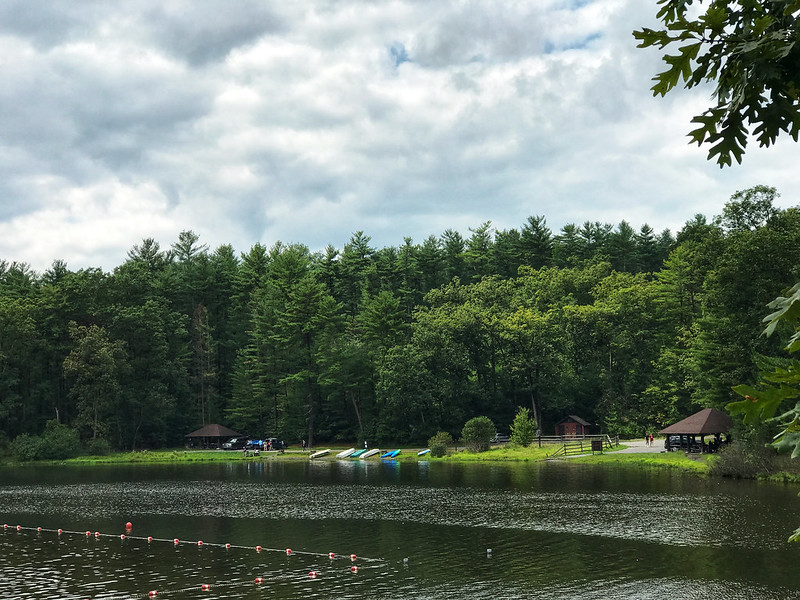


We’d passed the road to Shaver Creek Environmental Center and stopped on the way back. The buildings were closed for the holiday, so we relaxed on the deck’s Adirondack chairs. I kept hoping to hear a creek.
On the way to the park, V. spotted a plant she thought might be teaberry (ICE CREAM!). According to the folks of iNaturalist, it’s partridgeberry. Pretty, but perhaps not as weirdly tasty as teaberry. If you can’t get teaberry ice cream, try Clark’s teaberry gum. You won’t thank me, I think. It’s an acquired taste, associated with childhood 50 years ago.
